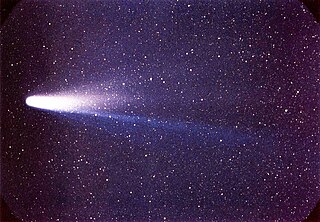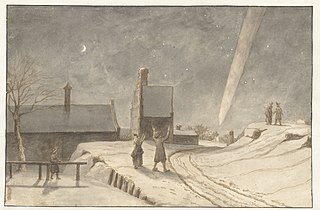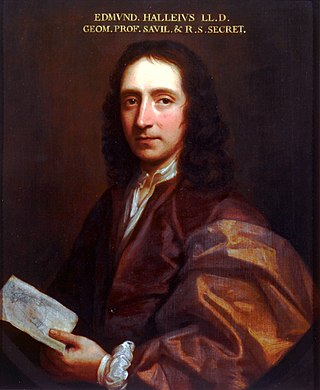
A comet is an icy, small Solar System body that warms and begins to release gases when passing close to the Sun, a process called outgassing. This produces an extended, gravitationally unbound atmosphere or coma surrounding the nucleus, and sometimes a tail of gas and dust gas blown out from the coma. These phenomena are due to the effects of solar radiation and the outstreaming solar wind plasma acting upon the nucleus of the comet. Comet nuclei range from a few hundred meters to tens of kilometers across and are composed of loose collections of ice, dust, and small rocky particles. The coma may be up to 15 times Earth's diameter, while the tail may stretch beyond one astronomical unit. If sufficiently close and bright, a comet may be seen from Earth without the aid of a telescope and can subtend an arc of up to 30° across the sky. Comets have been observed and recorded since ancient times by many cultures and religions.

1682 (MDCLXXXII) was a common year starting on Thursday of the Gregorian calendar and a common year starting on Sunday of the Julian calendar, the 1682nd year of the Common Era (CE) and Anno Domini (AD) designations, the 682nd year of the 2nd millennium, the 82nd year of the 17th century, and the 3rd year of the 1680s decade. As of the start of 1682, the Gregorian calendar was 10 days ahead of the Julian calendar, which remained in localized use until 1923.

Halley's Comet, Comet Halley, or sometimes simply Halley, officially designated 1P/Halley, is the only known short-period comet that is consistently visible to the naked eye from Earth, appearing every 75–79 years. It last appeared in the inner parts of the Solar System in 1986 and will next appear in mid-2061.

This article contains information about the literary events and publications of 1910.
The year 1910 in science and technology involved some significant events, listed below.
The year 1700 in science and technology involved some significant events.
The year 1821 in science and technology involved some significant events, listed below.
The year 1835 in science and technology involved some significant events, listed below.
The year 1819 in science and technology involved some significant events, listed below.
The year 1882 in science and technology involved some significant events, listed below.
The year 1786 in science and technology involved some significant events.

The year 1759 in science and technology involved several significant events.
The year 1758 in science and technology involved some significant events.
The year 1710 in science and technology involved some significant events.
The year 1705 in science and technology involved some significant events.
The year 1607 in science and technology involved some significant events.

C/1680 V1, also called the Great Comet of 1680, Kirch's Comet, and Newton's Comet, was the first comet discovered by telescope. It was discovered by Gottfried Kirch and was one of the brightest comets of the seventeenth century.
Events from the year 1705 in England.
Events from the year 1682 in England.

EdmondHalley was an English astronomer, mathematician and physicist. He was the second Astronomer Royal in Britain, succeeding John Flamsteed in 1720.